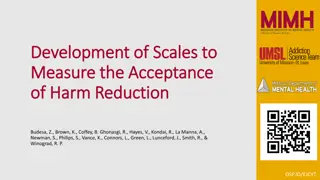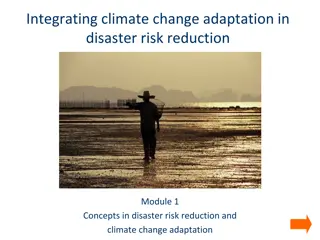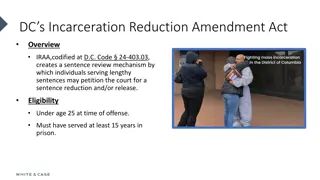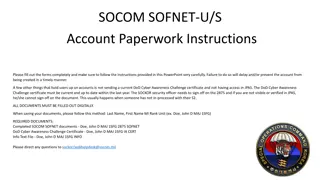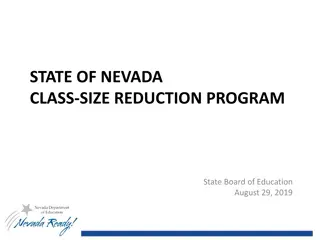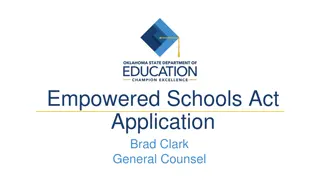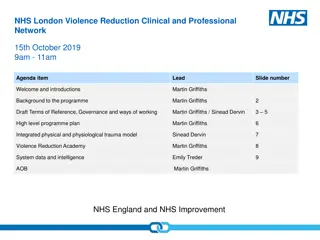Understanding Implications of IG Empowerment Act and Paperwork Reduction Act
The IG Empowerment Act provides beneficial provisions for Inspector Generals (IGs) such as exemptions from certain acts, including the Computer Matching Act and Paperwork Reduction Act. The Paperwork Reduction Act requires federal agencies, including IGs, to obtain OMB clearance before conducting surveys, which can be a complex and time-consuming process. Surveys play a crucial role in collecting data from agency employees and the public, aiding audits, inspections, and investigations. Maintaining survey quality is essential, and OIGs can ensure this without OMB review by adhering to recommended practices. Understanding survey dimensions and ensuring high-quality surveys are critical for effective program evaluation.
Download Presentation

Please find below an Image/Link to download the presentation.
The content on the website is provided AS IS for your information and personal use only. It may not be sold, licensed, or shared on other websites without obtaining consent from the author. Download presentation by click this link. If you encounter any issues during the download, it is possible that the publisher has removed the file from their server.
E N D
Presentation Transcript
IG Empowerment Act Paperwork Reduction Act Exemption Implications for OIGs Lee Giesbrecht, VAOIG
IG Empowerment Act Includes several provisions that support IGs: Exemption from the Computer Matching Act Exemption from the Paperwork Reduction Act Requirement that the GAO complete a study on prolonged IG vacancies during which an acting IG has served and report findings to Congress
Paperwork Reduction Act The Paperwork Reduction Act requires all Federal agencies to submit a clearance request to OMB in order to survey the public. IGs, along with all other executive agencies, have been required to comply with the Paperwork Reduction Act. Obtaining OMB clearance to conduct a survey is a lengthy, complex process. The process includes two rounds of Federal Register notices for public comment and can take 6 months or longer to complete. OMB tries to ensure that federal surveys are of high quality.
Collecting Data from Agency Employees Surveys can be used in audits, inspections, and investigations to collect data from program staff and management to help evaluate program functionality. For example, in a VAOIG audit, VA COTRs were surveyed about their use of a new, web-based contract management system to determine if they were using it as designed, whether the system was user-friendly, and what improvements users would suggest. One may also think about the less structured interviews with agency staff conducted as a part of audits as a type of survey.
Collecting Data from the Public Surveys can be used in audits, inspections, and investigations to collect data from those affected by an agency program. For example, a population of veterans could be interviewed about their experiences with VA care or benefits that are subject to audits.
Survey Quality A large part of what OMB aims to do in their clearance review is to ensure that agencies are conducting high quality surveys that will yield usable results. In the new guidance, CIGIE recommends that OIGs document their survey work as if they still had to comply with the PRA to ensure OIGs maintain transparency, self- governance, and continuity. What are the dimensions of quality in surveys? How can OIGs ensure they conduct high quality surveys without OMB reviewing their work? What will happen if OIGs conduct a survey that is lacking in one or more dimensions of quality?
Dimensions of Quality Correctly identifying analytical needs High quality questionnaire design Statistically sound sampling methodology Attempts to address non-sampling error problems Non-response bias achieve a high (75%+) response rate Coverage error ensure all members of the population are included or have a change to be sampled Measurement error pretest questionnaire, conduct interviewer training
Questionnaire Design We often take for granted what we believe respondents know. Can respondents answer our questions? Use clear, specific question wording. The questionnaire is used to standardize the data-collection process. Ask questions as worded. Avoid explaining or interpreting questions. Maintain neutrality. 8
Interview Flow Start with questions that are simple, non- threatening/sensitive, and engage interest. Organize questions by topic in a logical order to make the interview more conversational. Add transitional statements when changing topics. Go from general to specific questions. End with more sensitive items/demographics. Design questionnaire to minimize burden. 9
Modes of Data Collection Interviewer (auditor) administered Self-administered paper, snail-mail Web-based Limit use of free public web survey tools (i.e., SurveyMonkey) cannot maintain control of the data, safeguard PII, or promise confidentiality. May be able to enter into contract or agreement to address these issues.
Question Formats Open-ended or fill in the blank Respondent answers in his/her own words. Must prepare (code) data for analysis. Use on draft questionnaire to inform a closed-ended design. Closed-ended Response choices are provided. Number of response choices. Order of response choices. Use balanced response scales. 12
Balancing Response Scales Ensure responses are mutually exclusive and exhaustive. Use balanced scales Biased: Poor Fair Good Excellent Balanced: Very poor Poor Neither poor nor good Good Very good 13
Recall Issues Dates are poorly recalled. Errors increase with time since event. Telescoping people tend to report event occurring more recently than they actually did. Forgetting occurs more with passage of time and with minor, non-salient events. 14
Questionnaire Design Pitfalls Double-negative questions Can be confusing for respondents. E.g., I cannot say that this policy is working. Reword to, I think that this policy is working. Double-barreled questions Asks about two or more issues in one question. May be different answers for each issue. E.g., Are sufficient supplies available for drawing blood and setting up IVs? 15
Questionnaire Design Pitfalls Avoid leading questions instead, reword questions to include various responses: Do you agree with the agency s policy to ________? Do you agree or disagree with agency s policy to ________? Acquiescence bias some people may be more likely to agree (acquiesce) than others. Social-desirability bias people have a natural tendency to want to be accepted and liked, which may lead to inaccurate answers to questions on sensitive topics. 16
Sampling In many cases a sample of the population will be sufficient to address the analytic needs rather than attempting to survey the entire population. Probability sampling will allow measures of the precision of sample estimates as opposed to judgement or convenience sampling. Must assemble a sampling frame that includes all members of the population to avoid coverage errors. Complex sample designs that include stratification, clustering, and unequal sampling weights will require special calculations to obtain correct sampling error estimates.
Coverage Error Part of the target population is systematically left out of the data collection. Can lead to coverage bias if the portion of the population left out is different from the target population on a key characteristic. Level of bias is usually unknown - difficult and expensive to quantify. 18
Nonresponse Error Information not collected from all members of the population or missing from administrative records. Missing records (unit nonresponse). Missing fields (item nonresponse). Results in nonresponse bias if the portion of the population that is missing or has missing data is different from others on key characteristics. 19
Measurement Error A.k.a. Response Error Information obtained is different than the truth. Caused when respondent gives incorrect information or administrative records contain errors. Leads to measurement bias if some parts of the population are affected differently than others. 20
Measurement Error - continued Respondent reports Memory errors Misunderstands questions (questions poorly designed) Order effects and other cognitive effects. Interviewer-administered survey Correlated Response Error - errors are correlated within interviewer caseloads. Keeping caseloads as low as possible and training interviewers to act the same helps. 21
CIGIE Action on the Exemption from the Paperwork Reduction Act CIGIE aims to help OIGs identify and obtain the right skills to design and implement surveys. Established PRA working group. Working group drafted guidance to help OIGs maintain high, consistent standards when conducting surveys. Draft guidance addresses OMB supporting statement items that are applicable to OIGs and survey quality issues. Draft guidance includes references to survey design resources online. CIGIE considering training on survey design.






